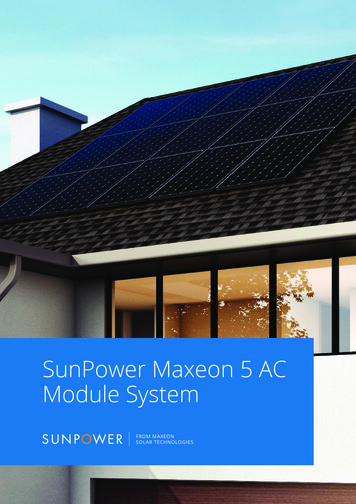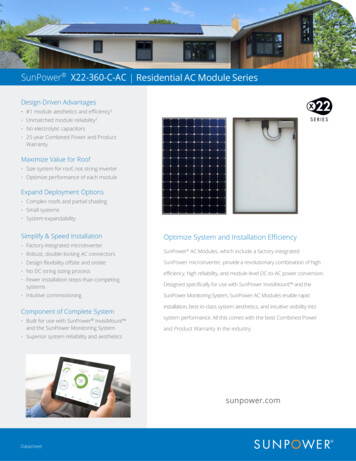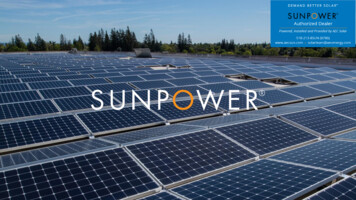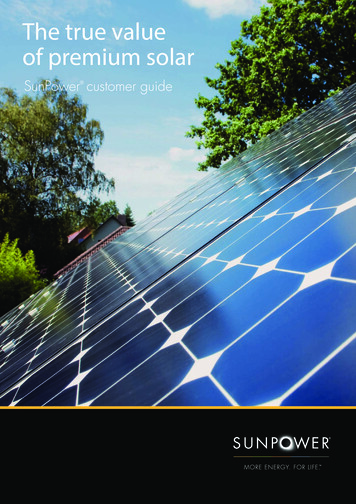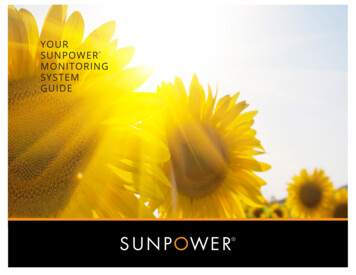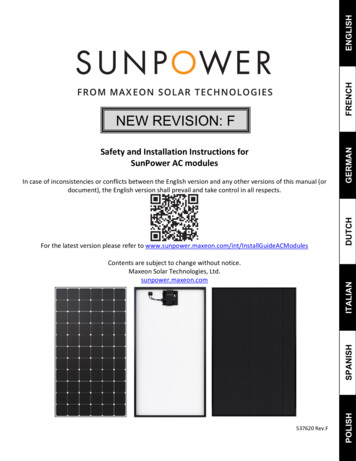
Transcription
ENGLISHFRENCHIn case of inconsistencies or conflicts between the English version and any other versions of this manual (ordocument), the English version shall prevail and take control in all respects.For the latest version please refer to 37620 Rev.FPOLISHSPANISHITALIANContents are subject to change without notice.Maxeon Solar Technologies, Ltd.sunpower.maxeon.comGERMANSafety and Installation Instructions forSunPower AC modulesDUTCHNEW REVISION: F
Table of Contents1.0Introduction . 31.1 Definition of Terms . 31.2 Disclaimer Liability . 31.3 Certified Body Certification Information . 31.4 Limited Warranty . 32.0Safety Precautions . 33.0Electrical Characteristics . 33.1 Fire Rating . 34.0Electrical Connections . 34.1 Equipment Grounding. 44.2 Connections to AC Circuits . 44.3 Cable Management . 44.4 Microinverters Connection . 45.0Module Mounting . 45.1 Site Considerations . 55.2 Mounting Considerations. 65.3 Handling of Modules during installations . 66.0Maintenance . 67.0Troubleshooting . 78.0Appendix (Supplementary Technical Information) . 7Electrical Characteristics and Module Frame Details. 7-8
Safety and Installation Instructions for AC ModulesIMPORTANT SAFETY INSTRUCTIONSSAVE THESE INSTRUCTIONS2.0 Safety PrecautionsBefore installing this device, read all safety instructions in this document.Danger! AC Modules generate internal direct current (DC) and outputalternating current (AC); and are a source of voltage when under load andwhen exposed to light. Electrical currents can arc across gaps and maycause injury or death if improper connection or disconnection is made; or ifcontact is made with module leads that are frayed or torn.1.0 IntroductionThis document provides safety and installation instructions for theSunPower AC photovoltaic (PV) modules described herein, all of whichbear both TUV and EnTest logos on the product label in respect to DCand AC (Microinverter) standards: Important! Please read these instructions in their entirety beforeinstalling, wiring, or using this product in any way. Failure to complywith these instructions will invalidate the Maxeon SolarTechnologies Limited Warranty for PV Modules and/or EnphaseEnergy Limited Warranty for microinverters. 1.1 Definition of TermsAC Module: Maxeon 5, Maxeon 6 and Perfomance 3 AC moduleDC Module: A typical photovoltaic solar module without microinverter unitattached.Enphase Microinverter: Smart grid ready IQ 7A microinverter converts the DCoutput of the PV module into grid-compliant AC power.Enphase AC cable: also called Q Cable, it is an AC cable with a length varying from1.3m to 2.3m depending to AC Module orientation (Portrait or Landscape), with3.3 mm2 cross section, double insulated, outdoor rated with integratedconnectors for microinverters. Maxeon Solar Technologies recommends the useat least of 2.0m long Q cable for greater flexibility in module installation in Portraitconfiguration. AC Module plugs directly into the Q that includes factoryintegrated connectors.Enphase Enlighten: Web-based monitoring and management software. Installerscan use Enlighten Manager to view detailed performance data, manage multiplePV systems, etc.DC Connector: Even if allowed by local regulation, Plug and Socket connectorsmated together in a PV system must be of the same type (model, rating) from thesame manufacturer i.e. a plug connector from one manufacturer and a socketconnector from another manufacturer, or vice versa, shall not be used to make aconnection. Approved compatible connectors: Tyco Electronics PV4S1.2 Disclaimer of LiabilityThe installation techniques, handling and use of this product are beyond companycontrol. Therefore, Maxeon Solar Technologies does not assume responsibility forloss, damage, or expense resulting from improper installation, handling, or use.1.3 Certified Body Certification InformationThis product intents to meet or exceed the requirements set forth by IEC 621093 for SunPower AC modules. The IEC 62109-3 Standard covers flat-plate PVmodules intended for installation on buildings; or those intended to befreestanding. The TUV certification does not include integration into a buildingsurface because additional requirements may apply. This product is not intendedfor use where artificially concentrated sunlight is applied to the module. Thismanual shall be used in combination with industry recognized best practices andSunPower AC modules should be installed by certified professionals only.1.4 Limited WarrantyAC Module limited warranties are described in the Maxeon Solar Technologieswarranty certificates obtainable at www.sunpower.maxeon.com (Refer to thelimited warranty document). Disconnect the AC source from all AC Modules and/or cover all modules inthe PV array with an opaque cloth or material before making or breakingelectrical connectionsDo not connect or disconnect modules when current from the modules in thestring or an external source is presentUse only the AC locking connectors in order to defend against untrainedpersonnel disconnecting the modules after they have been installed.All installations must be performed in compliance with the applicable localcodes.Installation should be performed only by qualified and suitably licensedpersonnelRemove all metallic jewelry prior to installing this product to reduce thechance of accidental exposure to live circuits.Use only insulated tools to reduce your risk of electric shock.Do not stand on, drop, scratch, or allow objects to fall on AC Modules.Broken glass, J-boxes, broken connectors, and/or damaged backsheets areelectrical hazards as well as laceration hazards. If a module is cracked afterinstallation, a qualified person should remove the module from the array andcontact the supplier for disposal instructions.Do not install or handle modules when they are wet or during periods of highwind.Unconnected connectors must always be protected from pollution (e.g. dust,humidity, foreign particles, etc.), prior to installation. Do not leaveunconnected (unprotected) connectors exposed to the environment. A cleaninstallation environment is essential in order to avoid performancedegradation.Do not block drain holes or allow water to pool in or near AC Module framesContact your module supplier if maintenance is necessary.Save these instructions!3.0 Electrical CharacteristicsElectrical characteristics and grid interaction data are shown in Table 2 and ACModule datasheet. It is the installer’s responsibility to set the grid profile and tocheck Enphase pre-configured country grid detail and this can be done withinternet access and by connecting into the Enphase Enlighten system.If an installation involves a SunPower AC module which does not appear on thislist, please consult the product label on the back of the module or visitwww.sunpower.maxeon.com for the product datasheet.As a reminder for DC modules: a photovoltaic module may produce more currentand/or voltage than reported at STC. Sunny, cool weather and reflection fromsnow or water can increase current and power output. Therefore, the values ofIsc and Voc marked on the module should be multiplied by a factor of 1.25 whendetermining component voltage ratings, conductor ampacities, fuse sizes, andsize of controls connected to PV output. An additional 1.25 multiplier may berequired by certain local codes for sizing fuses and conductors. SunPowerrecommends the use of open- circuit voltage temperature coefficients listed onthe datasheets when determining Maximum System Voltage.3.1 Fire RatingThe AC Module has the same fire rating as DC modules.4.0 Electrical ConnectionsModules must only be connected using the correct Enphase AC cable andintegrated connectors. Do not alter any connectors. 2022 Maxeon Solar Technologies, Ltd. All rights reserved. Specifications included in this document are subject to change without notice.3ENGLISHMAXEON SOLAR TECHNOLOGIES, LTD.537620 Rev.F
MAXEON SOLAR TECHNOLOGIES, LTD.537620 Rev.FEnsure that the cabling is not under mechanical stress (comply with bendingradius of 60 mm) and must not be bent on the direct exit of the connector orjunction box. The AC Module cable system features locking connectors which,after connected, require the use of a tool to disconnect. This defends againstuntrained personnel disconnecting the modules when under load. Enphase ACcable connectors are rated and tested to interrupt load current; however,Maxeon Solar Technologies recommends that you always open the utilitydedicated branch circuit breaker to remove power before plugging or unpluggingany connectors; install an AC isolator in accordance with local codes.4.1 Equipment GroundingModule grounding is required as per IEC 60364-7-712 and where deemedmandatory within the local regulatory framework. The purpose of the modulegrounding is both for protection and functional reasons. The functional aspect ofthis requirement is to enable the Inverter or power conditioning device to provideearth fault detection and any alarm indication. Maxeon Solar Technologiesrecommends using one of the following methods of grounding the module frame.In addition, to avoid corrosion due to dissimilar metal interfaces, Maxeon SolarTechnologies recommends stainless steel hardware between copper andaluminum. Testing should be done to validate grounding with temperature, saltenvironment and high current.1)2)3)4)Grounding using specified grounding holes: Use the mounting frameprovisioned grounding holes for connecting the module to the racking witha suitably sized earthing conductor.Grounding with clamp / claw: Clamp or claw can be installed between themodule and racking system. Align a grounding clamp to the frame hole, andplace a grounding bolt through the grounding clamp and frame. Ensure theclamp used when is fastened, will effectively pierce the anodized coating ofthe module and ensure suitable conductivity.Modules may be grounded by attaching a lay-in lug to one of the groundingholes on the module frame, and attach the ground conductor to the lug. Usestainless steel hardware (bolt, washers, and nut). Use an external-tooth starwasher between the lug and the module frame in order to pierce theanodizing and establish electrical contact with the aluminum frame. Theassembly must end with a nut that’s torqued to 2.3-2.8 Nm (for a M4 bolt).A lock washer or other locking mechanism is required to maintain tensionbetween the bolt and the assembly. The conductor must be attached to theground lug using the lug’s set screw.Modules may be grounded using a ground clip or ground washer or as partof a module clamp. These grounding clips/washers must be able toeffectively pierce the anodized coating of the module frame and establishsuitable electrical conductivity.All above solutions are possible but should be tested with the mounting structurefor grounding purpose.Limits may vary. Refer to local requirements to define the number ofmicroinverters per branch in your area.CAUTION! To reduce the risk of fire, connect only to acircuit provided with 20 A maximum branch circuitovercurrent protection.Below are the major installation steps:1. Install the Field-wireable connector pair, optional J-Box2. Position the Enphase Q CablePer module:3Position AC module and pop-out microinverters. Refer toSection 5.3 for illustation4Connect microinverters to Q Cable connector5Install AC Modules6Manage Q cable to module frame and railPer row:7Create installation map8. Terminate Q cable at last microinverter9. Connect to J-Box10. Energize system4.3 Cable ManagementUse cable clips or cable ties wraps to attach the AC cable to the racking. The cablemust be supported to avoid any cableundue sag as per local requirement.For Performance 3 AC modules, be carefulto not unplug the DC cable premounted infactory into specific cable supports.Dress any excess cabling in loops so that itdoes not contact the roof. Do not formloops smaller than 12 cm in diameter.4.4 Microinverters ConnectionRefer to the major installation steps defined in Section4.2and listen for a click:1) when the microinverters are pop out and2) when AC connectors engageInspect the AC connectors to ensure thatthey are not broken, misshapen, orotherwise degraded prior to connection.Cover any unused connectors on the ACcable with Enphase Sealing Caps. Listen fora click as the sealing caps engage.4.2 Connection to AC CircuitsIt is the installer’s responsibility to verify grid compatibility in your installationregion (240/380 or 4-wire 2-pole). The AC Modules must be connected to a utilitysource at the correct voltage and frequency in order to operate and producepower. They are not standalone generators and do not create AC voltage thus arenot capable of operation independent of a utility-generated AC signal. The ACModules must be connected only to a dedicated branch circuit. The AC cables andconnectors are certified and rated for the maximum number of AC units in parallelonly. When connecting modules, DO NOT exceed the following single AC branchcircuit maximum number of modules.The maximum number of microinverters that can be installed on each AC branchcircuit can be found in the Product's datasheet. This circuit must be protected byovercurrent protection. Plan your AC branch circuits to meet the following limitsfor maximum number of AC Module per branch when protected with a 20 amp(maximum) over current protection device.Maximum* IQ 7A Micros perAC branch circuit (240 VAC)Region: EU10Maximum* IQ 7A Micros perAC branch circuit (230 VAC)Region: APAC11CAUTION! Install sealing caps on all unused AC connectorsas these connectors become live when the system isenergized. Sealing caps are required for protection againstmoisture ingress.5.0 Module MountingThis section contains information for AC Modules. Ensure that you use the correctinformation for your module type.The Maxeon Solar Technologies Limited Warranty for PV Modules is contingentupon modules being mounted in accordance with the requirements described inthis section.5.1 Site ConsiderationsAC Module should only be mounted in locations that meet the followingrequirements: 2022 Maxeon Solar Technologies, Ltd. All rights reserved. Specifications included in this document are subject to change without notice.4
MAXEON SOLAR TECHNOLOGIES, LTD.537620 Rev.FMaximum Altitude: AC Modules can be installed in locations with a maximumof 2000 meter above sea level.Fig.1 With Rail SupportFor Maxeon 5 and Maxeon 6 RES AC:Operating Temperature: AC Modules must be mounted in environments thatensure that the modules will operate within the following maximum andminimum temperatures:Max. Operating Cell Temp. 85 CMax. Operating microinverter Temp. 60 CMax. AC Module Ambient Temp. 50 CMin. AC Module Operating Temp. 40 CDesign Strength: AC Modules are designed to meet a maximum positive (orupward, e.g. wind) and negative (or downward, e.g. static load) design pressurewhen mounted in the mounting configurations specified in Table 1 and 2 for thedetails on load ratings and mounting locations. AC Modules have also beenevaluated to IEC 61215 for a positive or negative design load of 3600 Pa with a1.5 Safety Factor.When mounting modules in snow-prone or high-wind environments, special careshould be taken to mount the modules in a manner that provides sufficient designstrength while meeting local code requirements.Important! The following image and tables show where to mount in moduleframe and the allowable load ratings corresponding to the mounting zoneschosen. To use the tables, identify the two mounting zones in which you wish tomount. You may choose to mount at any location in zones A, B, and C, as long asthe mounting points are symmetric about one axis of the module. Identify thecombination of mounting zones you have chosen in the table and then refer tothe corresponding load rating. Note also that load ratings are different formodules supported by rails; versus systems that attach modules underneath themodule frame or without rail support.For Performance 3 RES AC:Table 1. Design Load Ratings (Tested with FOS 1.5 Safety CEEBBCCBoltAAABACDDWind (up and down)/ Snow (down)(in Pa)MAX5/MAX6 RES ACw/o 00/2000/30002000P3 RES ACw/o NADO NOT MOUNT*Without Rail support means end mounted in long or short side frame.Additional Authorized Operating Environments:Modules can be mounted in the following aggressive environment according tothe test limits mentioned below:Salt mist corrosion testing: IEC 61701 Severity 6Ammonia Corrosion Resistance: IEC 62716 Concentration: 6,667 ppmExcluded Operating EnvironmentsCertain operating environments are not recommended for SunPower ACmodules, and are excluded from the Maxeon Solar Technologies LimitedWarranty for these modules. Maxeon’s modules should not be mounted a sitewhere it may be subject to direct contact with salt water, or other aggressiveenvironment. Maxeon’s modules should not be installed near flammable liquids,gases, or locations with hazardous materials; or moving vehicles of any type.Contact Maxeon Solar Technologies if there are any unanswered questionsconcerning the operating environment.5.2 Mounting ConfigurationsModules may be mounted at, appropriate orientation to maximize sunlightexposure.In order to prevent water from entering the junction box (which could present asafety hazard), modules should be oriented such that the junction box is in theuppermost position and should not be mounted such that the top surface facesdownward.In addition, ensure the module orientation also prevents the microinverter fromdirect exposure to rain, UV and other harmful weather events (ice/snow).We also want to remind that the watertightness is not ensured by the modulesbut by the mounting system and that drainage should be well designed for ACmodules. Maxeon recommends for a good performance of the system (reductionof soiling effect/water pooling) a minimum of 5 tilt angle. 2022 Maxeon Solar Technologies, Ltd. All rights reserved. Specifications included in this document are subject to change without notice.5
MAXEON SOLAR TECHNOLOGIES, LTD.537620 Rev.FClearance between the module frames and structure or ground is required toprevent wiring damage and allows air to circulate behind the module. Therecommended assembling clearance between each module installed on anymounting system is a minimum of 5 mm distance.Clearance between the module frame and roof surface is required to preventwiring damage and to enable air to circulate behind the module. Therefore aminimum of 50mm is required between the module frame and the roof surface.When installed on a roof, the module shall be mounted according to the local andregional building and fire safety regulations. In case the module is installed in aroof integrated PV-System (BIPV), it shall be mounted over a watertight and fireresistant underlayment rated for such application.surface of a module is sensitive to oils and abrasive surfaces, which may lead toscratches and irregular soiling.Be careful not to touch the micro-inverter while unloading the Performance 3 ACmodules, as the micro-inverter height exceeds the module frame slightly.Shipping Position: X 31.7mmInstall Position: X 46.7mmFor Peformance 3 AC modules, in order to provide better access of connectionfor AC cables into the microinverter, Maxeon recommends the followinginstallation sequence: When the microinverter is in lower position, then it is recommendedto install the modules from Left to Right. When the microinverter is in upper position, then it is recommendedto install the modules from Right to Left.Modules mounting systems should only be installed on building that have beenformally considered for structural integrity and confirmed to be capable ofhandling the additional weighted load of the modules and mounting systems, bya certified building specialist or engineer.AC Modules are only certified for use when their factory frames are fully intact.Do not remove or alter any module frame. Creating additional mounting holesmay damage the module and reduce the strength of the frame.Modules may be mounted using the following methods only:1) Pressure Clamps or Clips:Force must not deformMount the module withtop frame flange orglass may breakForce hasthe clips attached to theto belonger sides of the module.applied inRefer to the allowableline withranges in Section 5.0 (Tableframe1 ). Installers must ensurewallthe clamps are of sufficientstrength to allow for theFigure 1a: Clamp Force Locationsmaximum design pressureof the module. Clips and clamps are not provided by Maxeon SolarTechnologies. Clamps that secure to the top of the frame must not deformthe top flange. Clamps must apply force collinear with the ‘wall’ of themodule frame and not only to the top flange. Clamps shall not applyexcessive force to the frame, warp the top flange, or contact the glass these practices void the module warranty and risk frame and glassbreakage. Figure 1a illustrates locations for top frame clamp force. Avoidclamping within 50mm of module corners to reduce risk of frame cornerdeflection and glass breakage. When clamping to the module frame, torqueshall never exceed 15 N.m to reduce chances of frame deformation. Acalibrated torque wrench must be used. Mounting systems should beevaluated for compatibility before installing specially when the system isnot using Clamps or clips. Please contact Maxeon Solar Technologies for theapproval of the use of non-standard pressure clamps or clips where torquevalues are higher than otherwise stated.2) End Mount: End mounting is clipping/clamping of solar modules at thecorner of short side to the supporting rail. The end-mounting rail and clipsor clamps must be of sufficient strength to allow for the maximum designpressure of the module. Verify this capacity for both 1) clamps or clips and2) end mounting system vendor before installation.5.3 Handling of Modules during InstallationNever lift or move the modules using cables or the junction box under anycircumstances. Do not place modules face forward in direct contact with abrasivesurfaces such as roofs, driveways, wooden pallets, railings, or walls etc. The frontAC Modules are featured with antireflective coated glass and they are prone tovisible finger print marks if touched on the front glass surface. Maxeon SolarTechnologies recommends handing AC Modules with gloves (no leather gloves)or limiting touching of the front surface. Any finger print marks resulting frominstallation will naturally disappear over time or can be reduced by following thewashing guidelines in Section 6.0 below. Any module coverage (colored plastictarps or similar) during installation can lead to permanent front glassdiscoloration and is not recommended. The use of vacuum lifting pads can causepermanent marks on the front glass.Shading incidence need to be avoided during PV system operation. The system isnot supposed to be energized until the mounting scaffolding or railing have beenremoved from the roof.Systems should be disconnected in any cases of maintenance which can causeshading (e.g. chimney sweeping, any roof maintenance, antenna/dishinstallations, etc.).6.0 MaintenanceMaxeon Solar Technologies recommends visual inspection on a regular basis ofAC modules for safe electrical connections, sound mechanical connection, andfree from corrosion. This visual inspection should be performed by trained andlicensed personnel. The standard frequency is once a year according toenvironmental conditions.Periodic cleaning of AC Modules is recommended, but is not required. Periodiccleaning has resulted in improved module performance, especially in regions withlow levels of annual precipitation (less than 46,3cm (18,25 inches)). Consultinstaller supplier about recommended cleaning schedules for your area. Do notclean or spray modules with water during normal operation (module glass surfaceis hot). To clean a module, spray it with potable, non-heated water. Normal waterpressure is more than adequate, but pressurized water 100 bar (min 50 cmdistance) may be used. Fingerprints, stains, or accumulations of dirt on the frontsurface of the module may be removed as follows: rinse the area and wait 5minutes. Re-wet the area and then use a soft sponge or seamless cloth to wipethe glass surface in a circular motion. Fingerprints typically can be removed witha soft cloth or sponge and water after wetting. NEVER use harsh cleaningmaterials such as scouring powder, steel wool, scrapers, blades, or other sharpinstruments to clean module glass. Use of such materials on the modules will voidthe product warranty.7.0 TroubleshootingMake sure to follow all safety precautions described in this installation manual.The microinverters are monitored by Enphase Enlighten system. If a module isfound to not produce power through the Enphase Enlighten System, pleasecontact Enphase as the first point in the trouble shooting process. If Enphase 2022 Maxeon Solar Technologies, Ltd. All rights reserved. Specifications included in this document are subject to change without notice.6
MAXEON SOLAR TECHNOLOGIES, LTD.537620 Rev.Fmicroinverter is found to be functioning properly, Enphase will contact MaxeonTechnical Support directly.Troubleshooting an inoperative microinverter, please follow the Enphasetroubleshooting process:1. Web forms – send an email through orm8.0 Appendix (Supplementary Technical Information)1. Enphase IQ7 Installation and Operation ion-manual2. Enphase Installer Toolkit ttingstarted/commission2. Call centerEuropeNetherlands: 31-73-7041633France/Belgium: 33(0)484350555Germany: 49 761 887893-20UK: 44 (0)1908 828928APACMelbourne, Australia: 1800 006 374New Zealand: 09 887 0421India: 91-80-6117-2500Enphase Installer Toolkit is the mobile app where you can view themicroinverter serial numbers and connect to the IQ Envoy to track systeminstallation progress. To download, go to http://www.enphase.com/toolkit andlog in to your Enlighten account.Getting Started ingStartedGuide SystemVerificationUsingInstallerToolkit InsideSystem.pdfInstallation Troubleshooting :3. Claiming process through Enlighten for support-a
Enphase Enlighten: Web-based monitoring and management software. Installers can use Enlighten Manager to view detailed performance data, manage multiple PV systems, etc. DC Connector: Even if allowed by local regulation, Plug and Socket connectors mated together in a PV system must be of the same type (model, rating) from the
